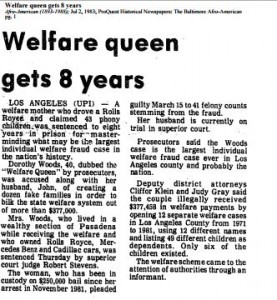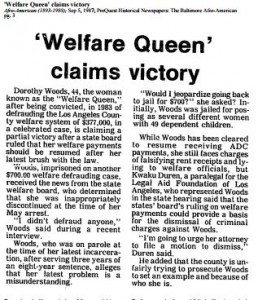
This is the third in a series of articles about laws that have significantly impacted Black women in America.
On Aug. 22, 1996, then-U.S. President Bill Clinton signed the Personal Responsibility and Work Opportunity Reconciliation Act (PRWORA), keeping his campaign pledge to “change welfare as we know it” and signing the dotted line on Republicans’ “Contract with America.” And while there are many who, almost 20 years later, tout the measure as being a resounding success, many social scientists, feminists and human rights activists see the reform as having had a particularly deleterious impact on African-American women.
The PRWORA was a reversal in paternalistic, protectionist social welfare policy embodied in the “mother’s pensions” that were instituted by states in the early 19th century to assist women – usually widows – who did not have a male breadwinner in the home.
“The rationale was that they were providing a social service to the state by virtue of the fact that they were raising children,” said Sonya Michel, history professor at the University of Maryland.

The accommodation was not, however, equitably provided to African-American women. And, when the New Deal moved welfare from the states and instituted the federal Aid to Families with Dependent Children program (AFDC) in 1935, officials found ways to disqualify Black women for such things as having a man in the house—even if he was not the children’s father.
“Part of it was the assumption that African-American women were unlike White women—during slavery and after African-American women were always expected to work,” Michel said. “African-American women have always had a disproportionately high rate of participation in the workforce compared to White women.”
During the Civil Rights Movement, courts struck down many of these disqualifications—in 1968’s King v. Smith, for example, the U.S. Supreme Court held that AFDC funds could not be withheld because of the presence of a “substitute father” who visited a family on weekends.

The legal victories made more women—African-American and divorced or never-married mothers—qualify for aid and that, Michel said, is when the tide began to change.
“This did not sit well with White lawmakers, particularly those from the South,” she said.
Increasingly, conservatives began to demonize the AFDC and its recipients, saying the policy, among other things, encouraged teen and out-of-wedlock pregnancies and had led to the destruction of families.
“There were some pretty ugly rhetoric in the early years,” said Donna Pavetti, vice president for Family Income Support with the Center on Budget and Policy Priorities.

Suddenly, full-time mothering was no longer seen as a viable occupation—at least among the poor. And those mothers—particularly Black mothers—who accepted public assistance began to be viewed as undeserving parasites depending on society’s largesse to finance their sexually profligate and irresponsible lifestyles. Those tropes, particularly that of the “welfare queen,” an oft-cited character in Ronald Reagan’s 1976 presidential campaign, came to define the urgency behind welfare reform and became a caricature of poor Black women that has endured to this day.
But the characterization of welfare as a “Black problem” was based on false premises, experts said.
“What’s remarkable about the general association of black people with welfare and handouts in the popular culture — that stereotype — is that it’s almost a perfect inversion of American history,” said University of Minnesota sociologist Joe Soss, who has studied welfare reform for more than a decade, in a 2014 interview with BIllMoyers.com.

“For much of the 20th century, and certainly in the earlier history of this country, we had all sorts of race-specific programs that channeled benefits to whites and excluded everyone else,” he continued. “So until very recently, in many ways we have this long history of a white-centered welfare state. But after that time, when victories were achieved that actually allowed for some equality of access to those programs, that very equality became the basis for saying, ‘Oh, this is all about African-Americans and it’s just a handout to this racially targeted group.’”
Feminist critics such as Barbara Ehrenreich argued that PRWORA was motivated by both “racism” and “misogyny.”
“The stereotype of the welfare recipient—lazy overweight, and endlessly fecund—had been a coded way of talking about African Americans,” she argued in an April 2002 article in The Progressive.

And, the law not only stigmatized single-mother households as being “inherently defective,” but also advanced the long-held negative stereotypes about Black women’s sexuality.
“In the reformers’ view, welfare recipients were moral outlaws, and they were this way because welfare supported them in their slovenly, sexually indulgent ways,” she wrote. “Even welfare itself was sexualized in the reformers’ overheated imaginations: It had ‘cuckholded’ black men, usurping their rightful place as breadwinners, leaving them emasculated and demoralized.”
Welfare reform proponents further argued AFDC had entrenched generational poverty and created a culture of dependency that discouraged welfare recipients from finding self-affirming employment.
“We’re in danger of creating a permanent culture of poverty as inescapable as any chain or bond,” said Reagan in a radio address to the nation on welfare reform, Feb. 15, 1986.
Clinton echoed those sentiments at {PRWORA}’s introduction, saying “the current welfare system undermines the basis values of work, responsibility and family, trapping generation after generation in dependency and hurting the very people it was designed to help.”
He added, “We have an opportunity to make welfare what is was meant to be: a second chance, not a way of life.”
Those reforms included: replacing AFDC with the Temporary Assistance to Needy Families (TANF) program, which gave more power to states to design their welfare programs through federal block grants, which depended on states reducing their welfare caseloads; limiting lifetime welfare benefits; creating stricter requirements for food stamp eligibility; instituting work requirements; reducing immigrant welfare assistance; enhancing enforcement of child support and others designed with an eye to encouraging two-parent families and discouraging out-of-wedlock births and increasing the workforce.
Many civil rights groups and Black lawmakers opposed the bill, due to its demonization of those – particularly Black women – on welfare and because of its punitive nature.
In the years since the “reform,” studies have found an overreliance on punitive measures to restrict welfare caseloads—measures that were often racially discriminatory.
“States with higher percentages of blacks and Hispanics on their welfare rolls have been significantly more likely to impose strict lifetime limits on aid, family caps limiting benefits for women who have children while receiving aid, and the toughest sanctions for non-compliance with program rules. Interestingly such racialized patterns do not emerge for state choices regarding supportive TANF benefits, but they are robust for directive and punitive policies,” according to “The Color of Devolution: The Politics of Local Punishment in the New World of Welfare.”
{PRWORA’s} detractors also felt it did not address the underlying problem of poverty.
For example, during a hearing of Clinton’s bill before the House Ways and Means Subcommittee on Human Resources, then-Rep. Donald Payne, a Congressional Black Caucus member from New Jersey, argued that many welfare recipients accepted aid out of necessity and not choice. He said many would come off the welfare rolls if jobs that offered livable wages were available and child care and housing were affordable, recalls author Michael D. Mint in the book, {Oversight: Representing the Interests of Blacks and Latinos in Congress.”
“Providing jobs and job security will change system to one that promotes and encourages self-sufficiency; however, we are unable or unwilling to invest the necessary resources in our families,” Payne argued.
But that investment in livable jobs never really transpired, Pavetti said.
“There has never been a huge commitment of resources to providing sound job opportunities,” she said.
In fact, on average, states spend only 8 percent of TANF funds on work programs—some states spend as little as 1 percent.
PRWORA proponents point to vastly reduced welfare caseloads and increased employment figures after the law’s passage as a sign of its success. But those trends could be mostly attributed to a simultaneous boom in the economy—and not necessarily to welfare reform, social scientists say. In fact, those claims of welfare reform’s success fail to account for employment numbers that have steadily fallen since 2000, nor do they consider the conditions of those who were booted off the welfare rolls.
In fact, several social scientists and activists predicted PRWORA would plunge millions into poverty.
Peter B. Edelman, who resigned as an assistant secretary at the Department of Health and Human Services in protest of PRWORA’s passage, cited studies by HHS and the Urban Institute which predicted the bill would “move 2.6 million people, including 1.1 million children, into poverty,” and further, reduce the income of 11 million families, many of them with incomes just above the poverty line.
“What we know about conditions for those families is that they became more distressed,” Pavetti said. “TANF provides a safety net for far fewer families,” even in times of greatest need, such as the recent recession, she added.
A CBPP assessment of the program released last August found several disturbing trends:
For every 100 American families in poverty, only 25 receive TANF funds, compared to 68 out of 100 indigent families who received assistance under AFDC.
TANF also plays a much smaller role in addressing poverty. While TANF monthly caseloads have fallen by almost two-thirds in the past 18 years — from 4.7 million families in 1996 to 1.7 million families in 2013 – poverty and deep poverty has worsened. The number of families with children in poverty hit a low of 5.2 million in 2000, but has since increased to more than 7 million. Similarly, the number of families with children in deep poverty (with incomes below half of the poverty line) hit a low of about 2 million in 2000, but is now above 3 million.
Much of that, experts argue, was the lack of access to sound, well-paying jobs with health and other benefits that could allow people to pull themselves out of poverty.
The ethos promoted by PRWORA is, “Any job, no matter how dangerous, abusive, or poorly paid, can be construed as better than no job at all,” Ehrenreich, the feminist critic, argued. And, because TANF grants to states are cut if they fail to meet work requirements, many welfare recipients are pushed “to take whatever jobs are available, and usually the first job that comes along.”
Many studies over the years have shown that women of color are the least paid workers in the labor force and endure other challenges at the lowest economic rung.

